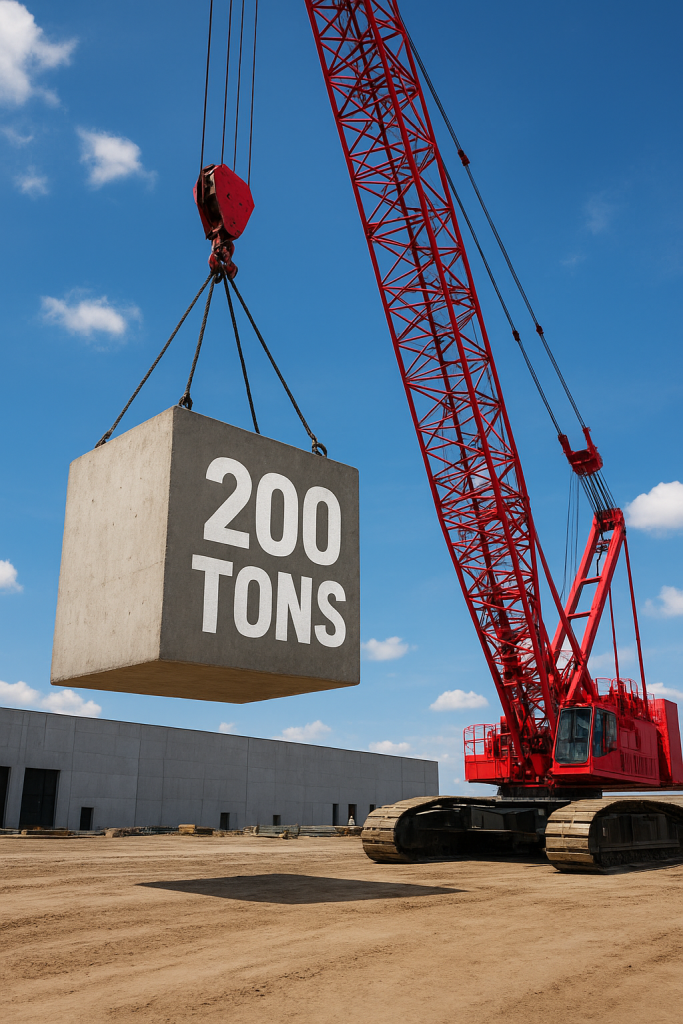Crane vs 200 Tons: What Really Happens?
Have you ever stopped and asked yourself, “How on earth does a crane lift 200 tons?” Not 20 bags of cement. Not a bus. Not even a bulldozer. I’m talking about 200 tons – the weight of about 130 small cars or a fully loaded Boeing 737.
If you’ve been curious but never got a simple explanation, relax. You’ll learn and go through it like no engineering jargon, no confusing terms – just real, clear talk.
First, how heavy is 200 tons?
Put it into perspective.
• 1 ton = 1,000 kilograms
• 200 tons = 200,000 kilograms
That’s the weight of:
• A large passenger plane
• 20 adult elephants
• More than 300,000 bricks
When a crane lifts 200 tons, it is not a small task. It’s a carefully planned operation involving power, precision, and safety.
Not all cranes can lift 200 tons
If you picture the small yellow crane you usually see at building sites, forget that. Lifting 200 tons needs heavy-duty cranes like:
• Crawler cranes
• Tower cranes with additional attachments
• Mobile hydraulic cranes
• Floating cranes (used at ports)
Some of these machines are taller than a 20-storey building and cost millions of dollars. They don’t just show up and start lifting. Everything starts with planning.
Step 1: The ground must be tested
Before lifting anything, experts first ask one question:
“Can the ground handle this weight?”
A crane lifting 200 tons is not just holding that weight in the air. The ground must carry the weight of:
The crane itself (which can weigh 50–500 tons)
The object being lifted (200 tons)
Any extra tools, counterweights, and crew
If the ground is weak, the crane can tip, sink, or collapse. So engineers check the soil, level the area, and sometimes build temporary platforms.
Step 2: The crane must be balanced
You don’t just hook 200 tons and lift. If the crane is not balanced, it can lean, twist, or fall.
That’s why counterweights are used. These are giant blocks of metal placed on the crane to balance the load. Some cranes use 100 tons of counterweight just to safely lift 200 tons.
It’s like holding a full jerrycan with one hand – you naturally lean or balance with the other arm. Cranes do the same, but with much more math involved.
Step 3: The load is calculated before lifting
Before a single hook touches the object, experts already know:
• How much the object weighs
• Where its center of gravity is
• How high it needs to go
• How far it needs to move
• What the wind speed is
• How many cables or slings are needed
No guessing. No hoping. Everything is pre-measured.
Step 4: The rigging team takes over
“Rigging” simply means connecting the load to the crane.
This involves:
• Heavy-duty steel cables
• Shackles and hooks
• Lifting beams or spreader bars
• Safety inspections
The riggers make sure nothing slips, breaks, or tilts during the lift. One wrong move here can cause a disaster.
Step 5: The signal person gives the commands
A crane operator doesn’t work alone.
There’s always a signal person or spotter on the ground. This person communicates using radios or hand signs.
Their job is to:
• Guide the lift
• Communicate with the operator
• Watch for obstacles or danger
• Confirm when it’s safe to move
Without this coordination, a lift of 200 tons cannot happen.
Step 6: The actual lift begins – slowly
Now, this is the moment you’d hold your breath if you were watching.
The crane operator lifts the load slowly. No rushing. If anything looks wrong, the lift stops immediately.
Why slow?
Because when 200 tons moves even one meter, the pressure, stress, and balance all change at once. Slow lifting helps prevent twisting, sudden tilts, or snapped cables.
Step 7: The height and distance change everything
Here’s something many people don’t realize:
A crane can lift more weight when lifting straight up
But as the boom (arm) stretches outward, the lifting capacity drops.
For example:
• Lifting 200 tons at 5 meters radius might be possible
• But at 25 meters radius, the same crane may only handle 50 tons
This is because the load creates a longer lever, increasing the risk of tipping.
So lifting 200 tons is often done close to the crane, not far away.
Step 8: Wind can stop the whole operation
Even a light wind can turn a safe lift into a risky one.
Why? Because a 200-ton object has a large surface area, and wind can push it like a sail.
If wind speed is too high, the lift is delayed. Safety always comes first.
What could go wrong?
When something this heavy is lifted, one mistake can cause millions in damage or even loss of life. The most common risks are:
Crane tipping over
Cable snapping
Load swinging uncontrollably
Rigging failure
Ground collapsing
Poor communication
This is why only trained professionals handle such lifts – not just anyone with a machine.
How long does a 200-ton lift take?
The actual lifting itself may take just 5 to 20 minutes, but the planning, setup, and safety checks can take hours or even days.
You don’t just wake up, drive a crane in, and lift 200 tons. It’s a carefully managed event.
What kind of crane can do it?
Here are some real machines built for this job:
1. Liebherr LTM 1200-5.1 – Mobile crane that can lift up to 200 tons
2. Demag CC 8800 – Crawler crane that can lift over 3,000 tons
3. Sarens SGC-120 – One of the largest cranes in the world
4. Floating cranes – Used in ports to lift large ships, containers, and offshore structures
These machines cost millions of dollars and are operated by highly trained crews.




